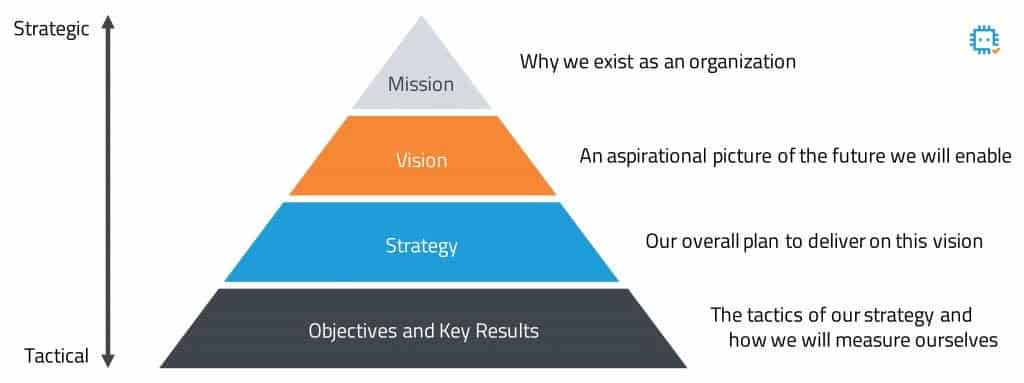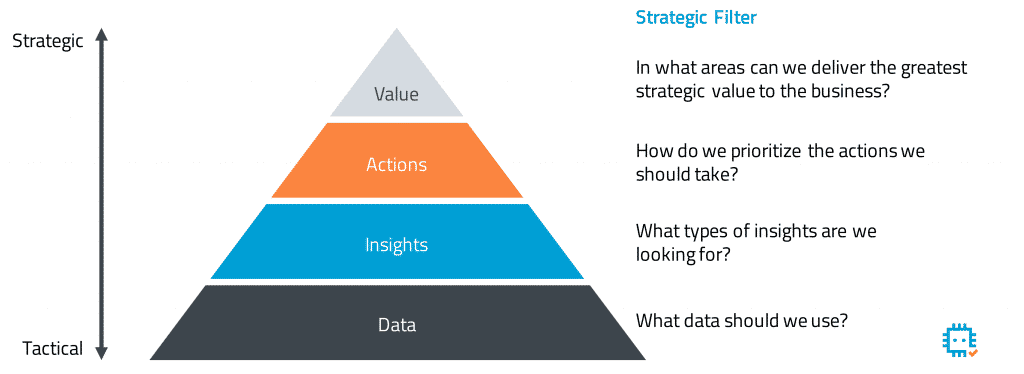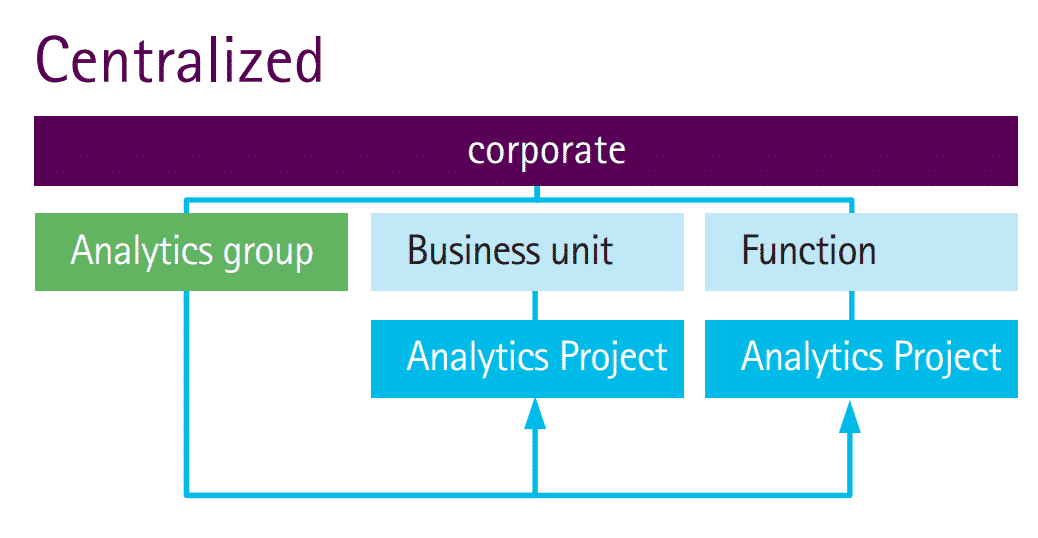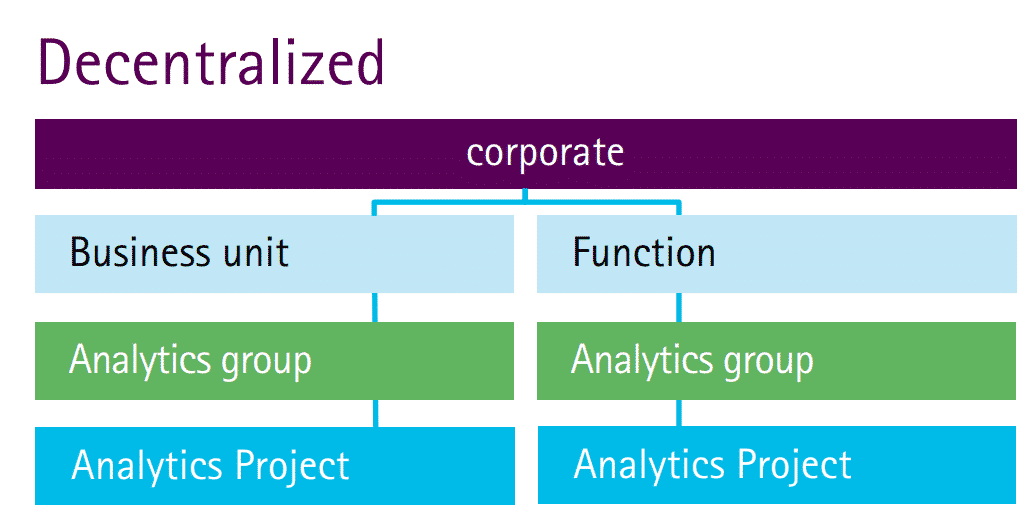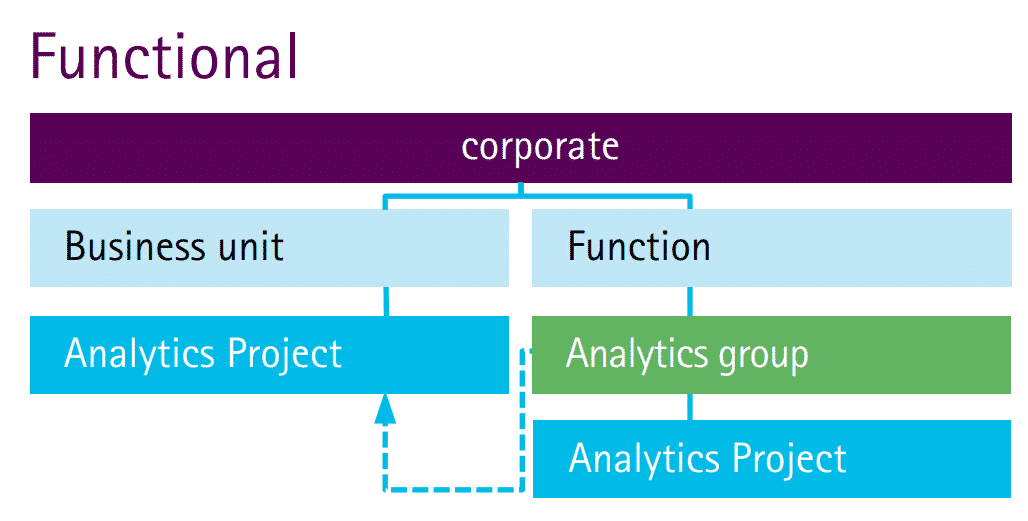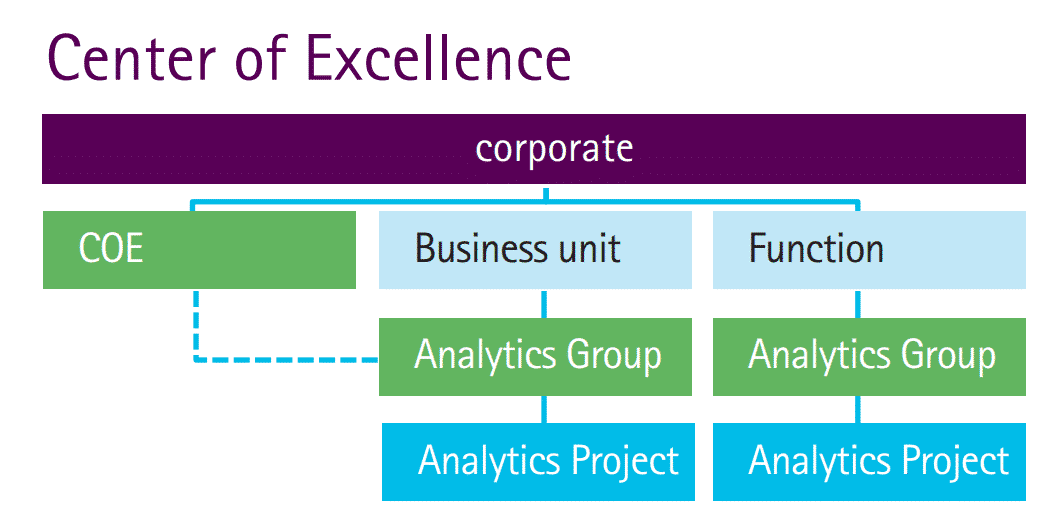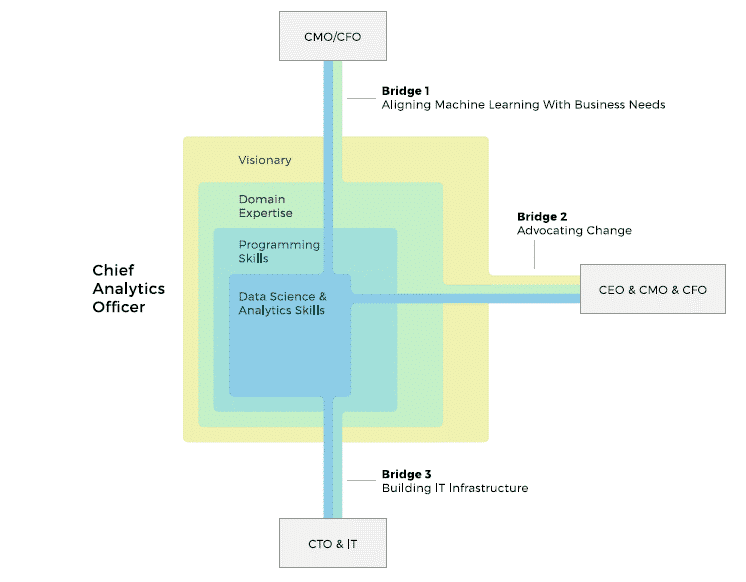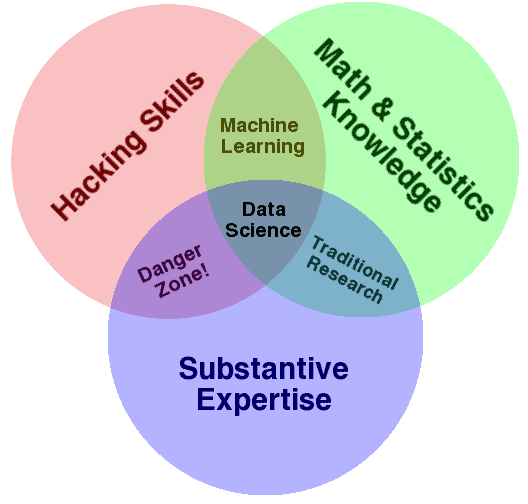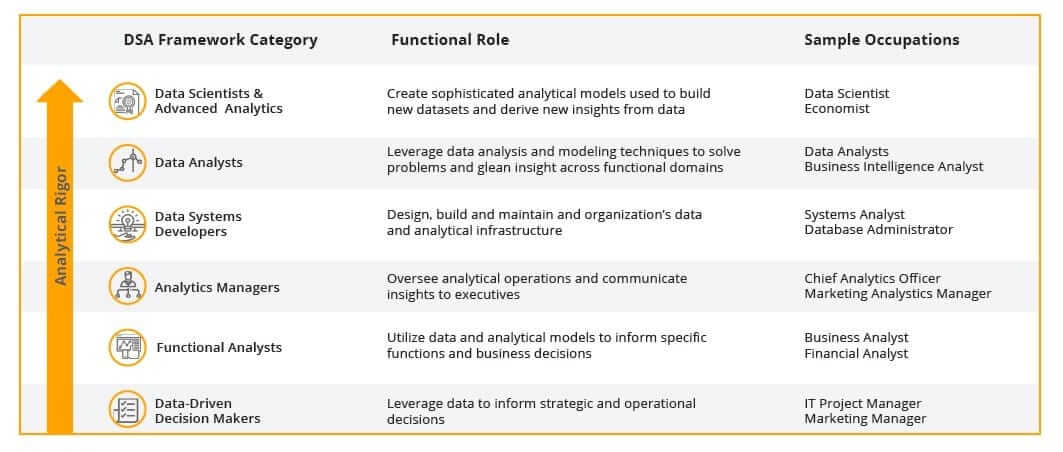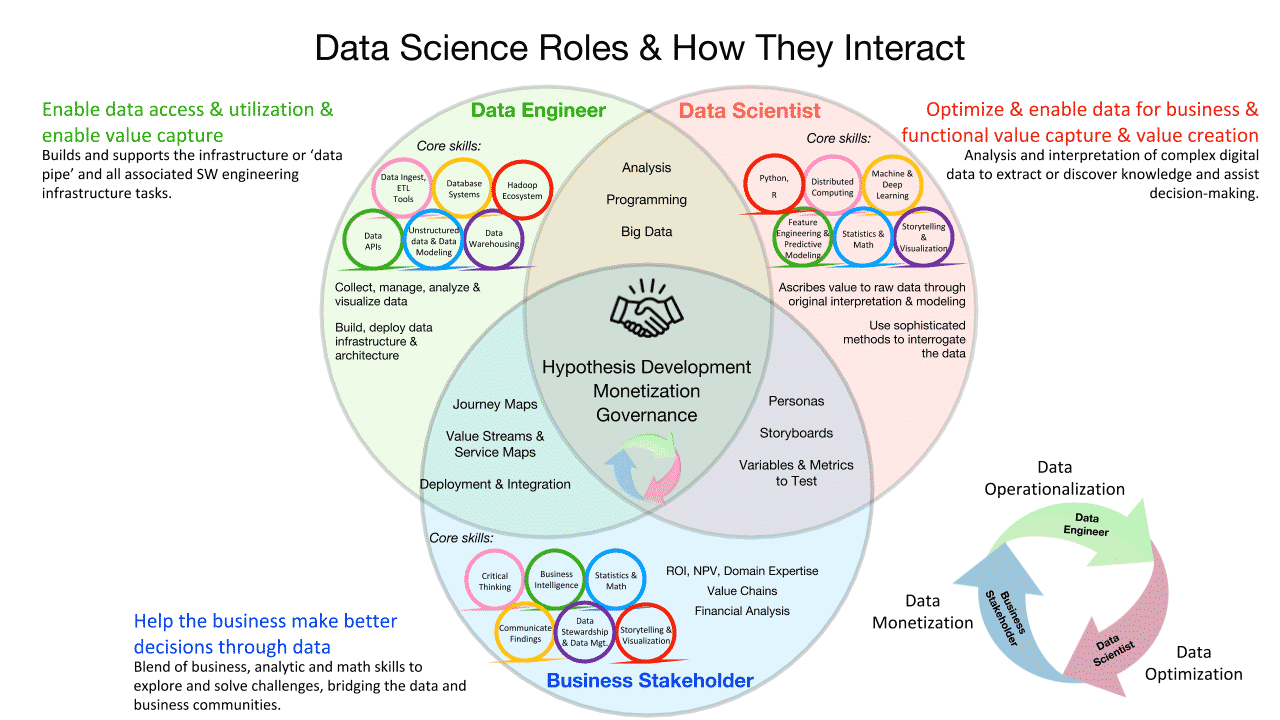Advanced analytics is a complex undertaking that presents big strategic opportunities but also big data challenges. Your organization needs the right data and analytics talent at the right time in the right place to take advantage. How do you do this? This guide provides an overview of key steps.
Looking for insights about how to build your advanced analytics team and capabilities? You’ve come to the right place!
Whether you’re a startup looking to hire your first data-related employee and wondering what capabilities you need, or a corporation looking to expand your advanced analytics capabilities to move up the data maturity curve, the key components of building great advanced analytics teams remain the same.

In this guide we’ve broken down the steps to building a team into 6 high level themes.
DEFINE YOUR DATA VISION AND STRATEGY
STRUCTURE YOUR ADVANCED ANALYTICS ORGANIZATION
DEVELOP AND DEMOCRATIZE ANALYTICS SKILLS
Click on any of these links to go straight to that topic or simply read on. In the sections that follow we provide you with research and experience-based thought leadership, “Chip’s Tips” and links to helpful resources that will equip your organization with frameworks for building a strategic advanced analytics team!
Define your data vision and strategy
Before you begin the journey of building your advanced analytics team, the folks in your C-suite have some thinking to do. Gather the team and go on a retreat to discuss high level strategic questions such as:
- What’s our corporate mission, vision and competitive strategy?
- What should our advanced analytics team achieve that is aligned with our mission/vision?
- What data and infrastructure does the advanced analytics team need to accomplish this?
- What data-related resources should our company prioritize and organize to achieve our mission?
- This strategic thought process might look something like the top to bottom path depicted in the figure below.
At the top strategic level you want to integrate and align data and analytics into your corporate mission and vision and decide how data will be used as a competitive advantage. This means for example, deciding that managers will be asked to challenge or support their business intuition and decisions with data. Ideally it means that your corporate strategy will, at least in part, be led by data driven insights.
Moving down the path at the tactical level your data strategy should support key corporate performance objectives and targeted results.
That sounds great, but complex – so how do we do this?
In our whitepaper “3 Steps for Building a Strong Data Science Team” we suggest 3 high level actions you can take to build your data strategy and develop a team to execute it.
If you’re short on time, here’s the super summary:
- Create and communicate your data-driven mission and data strategy/roadmap
- Create and implement a strategy for organizing and staffing your analytics team
- Challenge, develop and retain the team
We’ll cover all three of these themes in this guide, but suffice to say that you simply can’t achieve the 2nd and 3rd steps without creating your data roadmap first.
Why is it so important to have a data roadmap?
In a word:
VALUE
Borrowing from the previous framework, the figure below depicts the questions your organization should be answering in order develop and align your analytics with your corporate strategy to achieve maximum value.
First, at the strategic level, align analytics objectives with your organization’s strategic plan to create value.
You then prioritize these data related actions or projects according to how much value they would create, measured by “ROI”.
At the tactical level, you want to identify ways that data can generate insights that drive value creation.
Then you’ll need to put a data governance program in place as a foundational step in order to generate useful data that can be used in decision making. Data governance involves creating rules around data and analytics that support business objectives and help the organization balance out opportunities and risks.
How do you get from data to value creation?
Your data roadmap answers this question. It documents your organization’s current state of big data and strategy, identifies and outlines what future state you want to achieve strategically speaking, and maps out how to get there.
A data roadmap effectively lays out how your organization will operationalize and monetize advanced analytics. It will link data-related investment and activities to a business outcomes – value creation. It will connect your data strategy with your business strategy and performance.
Start by assessing the current state of your data, technology, processes and culture. Identify any issues and blocks (such as data not being clean or consistent) and the associated costs (you’ll need costs to determine the ROI of data projects). This can be quite a lengthy process with many stakeholders involved.
Next, take your list of strategic data initiatives prioritized by value creation and business impact that you created in Step 1. Look at them in the broader organizational context to identify desired outcomes. Most likely you’ll chose a few “pilot” projects to demonstrate that value can in fact be created through advanced analytics.
Then you’ll establish a high-level plan for implementing your new analytics strategy including the scope, costs, resources needed (including people and skills) and schedule. This rounds out your data roadmap.
But wait! That’s not all a data roadmap achieves…
Another reason that you’ll need to develop a data roadmap is for talent recruitment. An organized approach to data strategy demonstrates to advanced analytics professionals that you are serious about building top notch data capabilities. This is something you’ll need to do in order to attract top notch talent. And word on the street is that the best analytics talent is in big shortage, with no end in sight.
It’s also no secret that these guys and gals are expensive! So if you want to have an easier time recruiting, you need to show candidates for data science and analytics roles that you’re a serious organization who knows what it wants to achieve with advanced analytics. You need to be able to talk about what kinds of projects and priorities they will be working on. If you haven’t given this thought, they’ll see through this and go somewhere else. Fact.
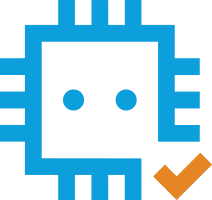
CHIP’S TIPS
Creating an effective data strategy is not as simple as hiring a few Data Scientists and data engineers and purchasing a Tableau license. First lay the foundation for creating a data driven organization by creating a data vision and strategy that will support your corporate vision and strategy. Create a roadmap for how to achieve this which includes a data maturity assessment, the implementation of a data governance program, and prioritization of data projects according to value creation and impact. And if you haven’t done this yet then go back and do it. When it’s done, don’t keep it a secret! Alert the stakeholders, candidates, shareholders/investors and your external partners.
Structure your advanced analytics organization
The second and perhaps most important component to building an advanced analytics team is the integration of the team within your company. To maximize the potential of your data science and analytics investments you need to design a team structure that supports your data roadmap.
• • •
According to McKinsey, less than 20% of companies have maximized the potential of advanced analytics at scale.
Why is this?
A misaligned analytics team structure, a suboptimal placement of the team within the organization or ill-defined workflows and processes hinder advance analytics usage. Your advanced analytics team is not simply added to your existing business structure. Rather, to transform your company through analytics, you need to create a new, scalable structure with associated processes and reporting lines.
There’s no “right” way to organize your advanced analytics team. Here are the most common organizational structures attempted by larger organizations:
- Centralized
- Decentralized
- Hybrid of these two
Each of structure has pro’s and cons. That said, there is one structure that is proving to be the most successful.
Centralized Team
Increasingly in very large corporations, Advanced Analytics is an entity that reports directly into a C-suite executive such as the Chief Data Officer, Chief Analytics Officer or the Chief Data Scientist.
If this is the plan for your organization, centralizing the data science and analytics function might make sense. A centralized advanced analytics team is independent from IT. It’s a department that has its own control, monitoring, budget and management
Why Use This Structure
The main advantage of a centralized model is the autonomy it grants to the team. The unit can apply analytics and data science tools and projects across the company wherever it is deemed to be valuable and supportive of corporate strategy. It can also make it easier to implement new changes in corporate data strategy without having to go to many individual data teams and force them to take on new processes.
Structuring a team as a central value creating unit also has the symbolic benefit of demonstrating that the company sees data as a highly strategic activity, just like Sales and Marketing. It sends this same message to external analytics talent, enabling the company to better attract, assemble and retain a highly talented team.
Why Not
One downside to this structure however is that if your centralized team becomes just a business unit among many buried in lines of bureaucratic communication, it will become siloed. Making small changes to tables and databases might be forced to go through some overly complex process that keeps the team from being productive and impactful.
And because a centralized advanced analytics unit is not working directly in the lines of business close to their specific value creating activities, its members may not understand the businesses very well, and so many of its analyses and recommendations may be ignored.
Decentralized Team
In a decentralized model, a function such as Marketing, or business unit such as a product line, hires its own data analytics talent to fulfil its particular requirements, effectively creating and controlling its own internal team. Decentralized teams all work independent of each other and work on priorities driven by the line of business executives, such as a Product Manager, who may or may not report to the C-suite. Typically, the leader of decentralized analytics teams is a hybrid domain and analytics expert. There is often no coordinating C-suite role.
Why Use This Structure
Companies often evolve to use a decentralized structure when there is no C-suite or enterprise-wide initiative to become a data driven company. Instead, advanced analytics efforts develop organically in different parts of the organization.
A decentralized structure might also be used in the early stages of data science to provide quick wins through pilot projects that demonstrate the value of advanced analytics and to provide a low risk way to identify and work out data-related issues.
Why Not
There’s a host of reasons not to use a decentralized data science structure. One is that unless an organization has a robust data governance and master data management model (most still have work to do in this area), inevitably people within the various business units and functions will be using different information with no single source of truth for data. This could present conflicting information or require a lot of time and effort to demonstrate the credibility of analytics conclusions. Both results hinder the ROI on analytics efforts as well as team morale.
Hybrid Organizational Structures
Given the tradeoffs between a fully centralized advanced analytics team and a fully decentralized one, some organizations have come up with options in between these two structures.
Functional Team
This model is like a centralized model, except that rather than being centralized at the corporate level, the advanced analytics team is placed under a business function, such as Marketing or Finance, that uses a lot of analytics to drive corporate strategic results. The team reports to the head of that function or department, such as the Chief Marketing Officer or Chief Financial Officer. Data Scientists and Data Analysts are then pulled to work on various business unit projects as needed.
You find this type of analytics team structure in companies with less mature analytics strategies or limited resources. For example, some financial institutions may also choose this model by putting most of their data and analytics talent in the credit and risk assessment department since that is such an important function to the overall business strategy.
Center of Excellence (COE)
This structure keeps the best of the centralized approach by creating an independent corporate advanced analytics organization that has a single strategic, enterprise-wide approach to data science and analytics. However, its team members are allocated to and embedded within different business units and functions as in a decentralized model.
This structure keeps the best of the centralized approach by creating an independent corporate advanced analytics organization that has a single strategic, enterprise-wide approach to data science and analytics. However, its team members are allocated to and embedded within different business units and functions as in a decentralized model.
The COE is led by a data-driven CEO, a Chief Analytics Officer, Chief Data Officer, or even a Corporate Strategy or BI Head. This leader is guided by corporate strategy, and ideally a data roadmap, and aligns team projects and resources according to these priorities.
A COE achieves a balanced structure whereby data and analytics activities are both highly coordinated and flexible, while allowing analytics experts to develop domain expertise and collaborate with business units on their strategic needs.
To this effect:
The COE can act as a “center of gravity” for all advanced analytics activities around which an ecosystem of internal and external partners is created.
A bonus of a COE structure is that it provides more interesting career paths for analytics professionals, Data Scientists, and machine learning engineers looking for meaning and challenge in their work. This in turn increases retention.
Due to these benefits, the Center of Excellence structure is increasingly adopted.
Leading corporations such as Microsoft and J.P. Morgan Chase, are in fact creating separate Center of Excellence teams that house new AI-related roles and reporting lines. At this point in time, for most companies however, it probably makes sense to centralize AI efforts alongside advanced analytics and data science in a single COE. This is because given the shortage of talent in this area, AI and data science team members need to be tightly coordinated and learn together.
Whatever structure you choose for your advanced analytics organization, the impact and tradeoffs regarding hiring, knowledge sharing, collaboration, careers and focus within the organization must be understood and the tradeoffs managed.
And in any case, there needs to be an overriding data governance program in place to support the unit and its goals. Finally, the structure of advanced analytics within any organization might never be as cut and dry as these organization schemas, but rather evolving and flexible to fit in with the evolution of the rest of the organization’s structure.

CHIP’S TIPS
Find a balance between centralized and decentralized team structures. Over-centralization and bureaucracy inevitably slow teams down. If the data unit is placed in a silo, there is a high risk of imbalance and misalignment with other units and business goals. Burying analytics teams in business units may hinder coordination around strategy and data sources. Therefore, one of the biggest advantages that companies can gain while implementing a data strategy is to find a happy medium between centralized and decentralized teams that is well integrated.
In most cases for corporations who are truly seeking to execute data-driven strategies and develop AI capabilities it makes sense to work towards creating a specialized, centralized advanced analytics/AI Center of Excellence.
The COE unit has independent resources and decision-making power that can create standards and simplify development decisions while improving the team’s ability to manage common tasks that every data team needs to perform to be effective. At the same time embedding teams within the business can help decentralize strategic decisions that are often department and domain specific.
Interested in learning about some real life team structure examples? Watch our interview a Data Science Lead from DellEMC.
Define skills and team roles
Once you have your data roadmap and initiatives identified and an idea of the team structure you want, you’ll have to map the requisite data, technology and advanced analytics skills needed to execute to your existing internal roles and skills (more on those later). Then decide which skills you can develop internally and which one you must hire for externally.
To do this management needs to understand what skills are in advanced analytics and data science.
Where do you start? Leadership.
A misaligned analytics team structure, a suboptimal placement of the team within the organization or ill-defined workflows and processes hinder advance analytics usage. Your advanced analytics team is not simply added to your existing business structure. Rather, to transform your company through analytics, you need to create a new, scalable structure with associated processes and reporting lines.
There’s no “right” way to organize your advanced analytics team. Here are the most common organizational structures attempted by larger organizations:
- Centralized
- Decentralized
- Hybrid of these two
Each of structure has pro’s and cons. That said, there is one structure that is proving to be the most successful.
As this schema shows typically your organization should have a Chief Analytics Officer or Chief Data Scientist who will be the first major hire. Even if you’re a startup or small company you have to hire someone to be in charge to drive data strategy and initiatives.
This person acts as a visionary for data strategy. This leader acts as the bridge between advanced analytics team and leadership from related areas such as IT or Marketing. With knowledge of what various business domains need, the CAO determines what data science and analytics skills and roles are required of the advanced analytics team to translate business goals into analytics initiatives.
What are Advanced Analytics Roles and Skills?
Defining skills and roles can get pretty complicated. For starters, the job title “Advanced Analyst” does not exist! The closest job title for a person with advanced analytics skills would be that of a “Data Scientist”, so let’s start there.
The now infamous Conway Venn diagram below attempts to describe what data science and its related skills sets are.
Confused? You should be! The term “Data Scientist” has been around since 2008 (centuries ago in “big data” years). With years of use and abuse by both employers chasing job candidates and candidates chasing high salaries, the job role of a “Data Scientist” has grown even more ill-defined.
IBM’s framework for data science and analytics roles provides a nice breakdown of the kinds of roles you see in the field of data science and advanced analytics.
Skill sets for different roles are varied and overlapping. The table below breaks specific skills down by common advanced analytics roles into priority and “T shaped” skills. T shaped skills help to bridge skills and tasks between the different roles.
Role |
Key Responsibilities |
Priority Skills |
“T shaped” skills |
|---|---|---|---|
| Data Engineer | Create and maintain data analytics structure Storing and processing data. Data collection warehousing and transformation. |
Database tools – Hadoop, MapReduce, HBase, SQL, noSQL, Python, Java, SAS ETL tools Data warehousing tools |
Coding languages – Python, C++ Statistical analysis |
| Machine Learning Engineer | Deploys and monitors trained models Develop sophisticated machines and systems that can learn and apply knowledge |
Probability/statistics Software engineering Algorithms |
Predictive modelling Data mining Communication skills Other coding languages DevOps |
| Data Scientist | Solve business problems and generate business insights using machine learning, data mining techniques Works with large unstructured data sets |
Python, R, C++, Java SQL, Spark Data cleaning/prep Data exploration Statistics/Math Modelling Data mining |
Communication skills Visualization skills Other technologies – Hadoop, AWS, Google Cloud |
| Data Product Manager | Serving as the link between the business/domain and the analytics team. Decision maker. | Market research / strategy development Communication Programming Design |
Math/Statistics Visualization Data Prep/Cleaning |
| Data Visualization Engineer/Analyst | Make large data sets useful and meaningful by presenting key information in a variety of ways that are appealing to users. | Graphic and user centric design skills BI tools/technologies Ability to work with large amounts of information and see/create the ‘bigger picture’ Comfortable with juggling facts, figures, and number crunching Communication skills, both written and oral Critical thinking: able to look at numbers, trends, and data and come to new conclusions based on the findings |
Math skills Analytical skills Modelling skills |
Just glancing over these responsibilities and skills it becomes apparent why building the right combination of skills and roles for an advanced analytics team is complicated. So, where do you start?
Start with the outcomes and skills you need, then define the “job”.
Take your corporate objectives and roadmap from Step 1, i.e. the state of your data or defined data science projects, and map advanced analytics skills, tasks and resources to these.
Matching skills and tasks to job roles is key. It’s important to do your homework…
Studies show that the skills companies seek when creating advanced analytics job descriptions do not necessarily match the profile and skills advertised on data and analytics professional resumes.
Why is this?
Well, we don’t like to point fingers (HR cough, cough), but we’ve been told both by analytics managers that it can be difficult to get non-technical recruiters and personnel to understand the nuances of different data skills, how they fit into different job requirements and to develop appropriate roles and screens.
The confusion understandable though – Data Engineers might need over a dozen relevant skills, especially big data engineer skill.
Does your non-technical staff need some help understanding advanced analytics skills and roles? Check out our Data Skills guide!
Judging by the variety of scores and relative areas of skill strengths and weakness that we see on our data science and engineering assessments,
It’s important to understand that when it comes to skills, data science is a “team sport”
Once again, a diagram helps to visualize what this “team” concept means in terms of aligning skills and roles. Below you data science roles broken down into key skill sets, responsibilities and where they overlap. It’s complicated! But it’s worth taking the time to understand these objectives, responsibilities, skills and roles all work together. It will help your organization to create the right job descriptions, which will in turn help you recruit the right talent.
Note that the “team” part where the three circles overlap involves identification of high priority projects (Hypothesis Development), identifying value creation opportunities (Monetization) and ensuring data governance (Governance)– all key areas we addressed in Step 1.
What this diagram also shows you is that skills can overlap. So you might be able to hire a data engineer that is lacking in analytical skills, but you can hire a Data Scientist who has these skills and have that person work alongside the data engineer to facilitate skills transfer. Likewise you might have business stakeholders, i.e. Product managers that are lacking statistics/math skills, but you can hire a Data Scientist who has these to help “democratize” these skills.
This is a concept called “cross-pollination” and it’s important to keep in mind when you are determing how many roles you need to hire for in order to start building or expanding your advanced analytics team.
There are numerous other job roles that could be filled to round out an advanced analytics team. The fact is, how you create and define your advanced analytics team roles will depend on a lot of factors including your company’s data maturity phase and size, the depth of your IT department, your industry, available resources, organizational structure, strategic objectives and more.
Want to know more about cross pollination and other strategies for hiring team skills? Hear from 2 CAO’s about how they create their advanced analytics teams.

CHIP’S TIPS
Start with leadership and your company’s data vision and strategy. Then define skills and technology resources needed to execute your data strategy and roadmap. Create job roles that fulfill these skills, keeping in mind how roles and associated skills may overlap. Spend less time worrying about hiring people for each job title and understand that advanced analytics is a team sport. Focus on understanding what skills one individual data specialist can fulfill and how you might leverage or complement those skills elsewhere.
Recruit and assess skills
The key component to becoming a successful data driven organization is not data, but people.
Your company’s people will identify business challenges and opportunities, collect and interrogate data and identify from it actionable and impactful insights that create value. Doing this successfully is what will allow your organization to climb from “data” at the bottom of the data strategy framework in Step 1 to “value” at the top.
Hiring the best and right resources is where value from data is derived for your organization.
How do you do recruit and hire the right talent?
Well, it’s challenging! We continuously hear from hiring managers about the challenges they have identifying and attracting necessary data science talent.
This is why QuantHub exists – to help solve the data talent shortage!
At QuantHub we aim to help companies understand what’s driving the shortage of data and analytics talent and how the market for skilled analytics talent is evolving to help inform the recruitment and assessment process and manage expectations.
Want to know what the market for analytics and data science talent looks like in 2019? Read our interview with Burtch Works.
Part of Step 3 was understanding what data skills and roles you need. The next step is to think about what kind of people you will recruit, what skills are critical, which are optional or can overlap and how you can assess for skills.
You may not need a full-blown Data Scientist with a PhD and eight years of experience on your team. You may just need a Data Analyst or a Data Engineer who can help you create better business intelligence systems or clean your data. Neither of these necessarily require a Data Scientist’s advanced skillset; yet companies consistently advertise and assess for advanced degrees and skills when they may not need all of these.
Carefully calibrating your search based on your actual and realistic data needs will save you and your organization precious time and money and allow you to focus on recruiting and assessing for the precise skills and qualifications that are most relevant.
As you saw in Step 3, it’s difficult to assess candidates for advanced analytics roles due to the wide variety and depth of potentially needed skills. This difficulty is further exacerbated by the industry’s tendency to try to avoid costly bad hires.
Our research has shown that because of this tendency, technical recruiting is at best a mixed bag, and such, contributes in part to the shortage of advanced analytics talent.
Read more about advanced analytics recruitment pitfalls in our 2 part series on technical recruiting and skills assessments.
Based on our research and experience, we put together the following list of recommendations and best practices for recruiting advanced analytics talent.
- Get job role savvy – Work out highly accurate job descriptions. If necessary, split one analytics job into separate roles, and/or determine which skills are deal breakers versus can-learns. To this effect in QuantHub assessments employers can weight skills by relative importance for a role. Qualified applicants will see that you have realistic expectations, so they will be more likely to apply or stay in your recruitment funnel.
- Develop realistic screens that fit the tight job market and eliminate bias – Give technical assessments and questions related to the actual job/skills for which you are hiring to respect candidates’ time. Use structured interview techniques such as standardized skill assessments to create a fair playing field.
- Give candidates a reason to join your company – Lead with your data vision and strategy. Rather than telling candidates about your company, tell them about your data roadmap and strategy, value creating projects they might work on and career paths within your center of excellence.
- Recruit for diversity – Since you can’t find all skills in one role, recruit for a portfolio of skills and cross pollinate.
- Take a long term view – Give up on the unicorn, fix your recruitment flaws (see previous suggestions), embrace lifelong learning, and create advanced analytics career paths and skill development programs. Be clear how the role you are recruiting for fits into your long term data vision and roadmap.
- Create partnerships with universities – This follows on the previous point. Undergraduate Data Science degree programs are on the rise. Start tapping into this new and diverse talent pool! You can read more about these new programs in our “Quantcrunch Report”.
- Sponsor data science meet ups, events and data challenges – Hosting data and analytics related events builds your company brand equity and image among top candidates – something critical to attracting and retaining talent. It also allows you to get to know candidates outside of the interview process.
- Recruit for cultural fit and soft skills – In addition to technical assessments, finding people who are a good cultural fit is just as important as finding expertise in a specific technical skill. Technical mindset, willingness to learn, and the humility to ask questions can often fill gaps in your team. Don’t forget the soft skills!
- Consider filling out your team internally – With the rise of data democratization and the “data citizen” it makes sense to start looking internally to identify and develop employees who show promise or a need to develop advanced analytics skills. You can benchmark or get a baseline of employee skills using an assessment like Quanthub’s, and from the results determine a plan for training and development (more on that in Step 6). In addition, internal recruits already have the cultural fit.
Check out our “Quantcrunch Report” to learn more about university data science and analytics programs.
For an glimpse at the talent you can tap into through this strategy, check out our Data Challenge winners!

CHIP’S TIPS
Do your technical hiring managers a favor now and take a good look at your recruitment and hiring process. Check for inherent bias and unrealistic expectations and remedy these, through objective skill assessments for example.
To attract top talent, start putting your corporate brand out in the analytics community, get to know potential candidates and talk about your data strategy and roadmap. Finally, in today’s tight talent market, it may pay to look internally for employees with talents that can be upskilled to develop into future advanced analytics team members. These same internal team members can help spread data skills throughout your company over time.
Develop and democratize skills
It’s become increasingly clear that data skills cannot remain siloed in the advanced analytics team if companies are to extract real value and create a competitive advantage from data science. This notion is called “data democratization”.
Data democratization enables the average end user to evaluate data without requiring help from the outside. Data democratization will be a game-changer for companies who embrace it because it leverages all that the advanced analytics team is doing to create that “data-driven culture” that so many strive for but fail to achieve.
How do you develop and democratize data skills?
As we mentioned previously, advanced analytics is a team sport. Dozens of skill sets are involved in developing a successful data analytics program. Nevertheless we still hear from seasoned analytics leaders that they have unrealistic expectations about what analytics professionals can achieve on their own.
Developing a true advanced analytics capability is a long-term proposition. It requires time and investment in people.
If you look again at Conway’s Venn diagram of skills and roles and the diagram of data science, you can begin to envision how you could use this concept not only to assess the capabilities of talent you are trying to hire, but also as a framework for thinking about current team member and other employee skill sets. Maybe some of your employees in IT have great programming skills (hacking). Others, such as those in Finance, may have research or analytical presentation skills.
We mentioned before the concept of “T shaped” skills in advanced analytics teams. This is one reason to invest in regularly assessing and developing team member skills. You can assess current employee skills in light of requisite advanced analytics skills and then build individualized development plans to improve their analytics capabilities.
For example, if you needed to add data engineering capabilities to your team, rather than going through a very expensive and time-consuming hiring process, you could instead develop a junior Data Scientist’s data engineering skills. You would assess the current capabilities of this individual across some of the data engineering skills depicted in Step 3 and then put together a personalized training program or curriculum to advance them along the different dimensions.
As for data democratization, a similar approach is valid. While your goal might not necessarily be to turn a business manager into a Data Scientist, you could assess managers for data science skills and then in light of the results develop training in key areas to help them learn to “think like a Data Scientist” and understand how best to collaborate with analytics team members.
QuantHub offers the ability for organizations to assess what skills their current advanced analytics and business talent has and what areas to target for individual development. We believe that this is a critical building block to developing successful analytics teams and capabilities. It allows companies to take a large team of analytics and business professionals and create a “baseline” level of skills to build upon and to inform future human capital management decisions related to analytics.
Remember the role of the CAO we discussed in Step 1? You’ll need many “bridge builders” in the organization to encourage the perception that data is valuable. This will require an investment in personal development and skills training.
What steps can you take?
Here’s a few ideas/concepts:
- Cross-pollination – This concept was first directly explained to us by the VP of Data Science at Protective Life. Essentially, you put a team with a diverse but complementary set of skills together in the same room and let them drink lots of coffee together. In this way you encourage team members to move out of their comfort zone and get exposed to new ideas and concepts, something that will also help with retention efforts.
- Cross functional collaboration – Closely related to cross-pollination and directly related to organizational structuring is the need to facilitate cross functional collaboration. Designers, marketers, product managers, and engineers all need to work closely with the advanced analytics team. This is one key reason to implement a center of excellence structure.
- Downtime – Data science and analytics professionals are naturally curious and seeking new challenges. They need to learn and grow to feel satisfied in their role. Many are Kagglers and like to compete in data science challenges. Allow team members a bit of free time during the week to seek new challenges and refresh their skills. This will also make them happier and likely result in better retention.
- Cross train/hybrid career paths – Move people from the advanced analytics organization into other analytically grounded areas such as operations management, digital marketing, or customer relationship management. This can be a nice half step away from the pure data science role while still learning new skills and encouraging business knowledge.
- Provide lifelong learning and development opportunities – This can be MOOCs, monthly topic presentations from outside or internal experts, scientific paper discussions, sponsored degree programs, data and analytics conferences and workshops.

CHIP’S TIPS
Accept that hiring ready-made Data Scientists is really a fading and increasingly expensive option, so you’ll have to start developing your team in-house and developing a portfolio of skills among many people. Start working on your long-term skills development roadmap now by regularly assessing and benchmarking both your advanced analytics team member’s skills, as well as the data skills of domain experts. As you progress in this plan to democratize data skills in your organization in 5 years when AI has “come of age” you’ll be armed with a team of homegrown and loyal advanced analytics professionals and business managers ready to help you take advantage of all that the future of advanced analytics has to offer.
Retain your analytics talent
Employees stay on average in a data science role for less than 2 years and it takes 3 months to come up to speed in the role. You’ll need to accept that there will be a certain amount of turnover in your future advanced analytics team.
However, that doesn’t mean that you shouldn’t try to hold your analytics team together for as long as possible. After all, you probably spent a lot of time and money to recruit and hire your team members.
The good news is that research shows that at a certain point, as analytics professionals mature in their role and life stage, they’ll be looking for a better work-life balance and a stable career.
Why is retention critical? QuantHub CEO explains with 3 pain points in this video.
How do you retain your advanced analytics team?
Understand this simple piece of advice one data science recruiter gave us:
For this kind of talent group, “It’s not all about the money”.
The same recruiter also told us that companies should be doing more to retain their data science and analytics team members.
On that note, here are a few suggestions for how to go about retaining top talent. Many of these mirror our suggestions for developing your team skills.
- Capabilities development – As mentioned in Step 5, investing in analytics talent development and skills advancement is the most basic requirement for retention. Analytics professionals are naturally curious and so you’ll need to find ways to engage and satisfy their curiosity or they’ll become curious about other jobs and projects elsewhere.
- Provide the “3 C’s” – Analytics professionals need context, challenge and collaboration. This means they need to understand how what they are doing will positively impact the organization. They of course seek challenge. And lastly, providing opportunities to work in teams throughout the organization and with the businesses will help them foster relationships and loyalty.
- Culture – This is the other “C” that is often overlooked or missing in an organization. If you want to keep top talent, then at the highest level your organization must communicate that the business embraces a data driven culture, and well frankly, will show some respect to what the advanced analytics team produces. At a minimum most people in the company should at least embrace and value data-backed insights, even if they cannot use them in their own area of influence.
- Empowerment – Smart people need a chance to prove themselves, explore and take risks. Analytics leaders should provide opportunity for team members to work autonomously from end to end on solving problems and identifying business opportunities. And then reward them when they get it right.
- Practice embedding – As described in the recommended center of excellence organizational structure, retaining data science and advanced analytics talent requires embedding – placing analytics talent to work in business-focused departments to make them report centrally, collaborate better, and help them feel they’re part of the big picture.
- Provide Work/Life Balance – We’ve seen companies be very deliberate about this and it works. Offer clear career paths and options within the organization. As a professional begins to want to settle down, they’ll be less apt to want to change organizations if they see potential and interesting career paths. Some companies have even begun opening satellite offices away from major data science hubs like New York City, and in less busy areas such as the suburbs of Chicago to offer better work/life balance and a stable affordable lifestyle.
- Support – It sounds simple enough, but if an analytics team doesn’t have the tools or resources or decision-making power to have an impact, morale suffers. There are too many other opportunities out there to make an impact to sit around in a job role that isn’t supported. For example, a prime complaint of Data Scientists is that they spend too much time on data prep and cleaning. So, they leave.
- Recognition – Ensuring that dialogue between Data Scientists leader and the C-suite occurs often enough increases the likelihood that Data Scientists’ suggestions are actually implemented. This might allow a Data Scientist to develop a reputation for knowledge inside the organization. People will want to hear what ideas they have to offer, which gives them more skin in the game.

CHIP’S TIPS
When it comes to retaining top analytics talent, take good note of what, Elena Grewal, the Head of Data Science at AirBnB said about building an advanced analytics team in her organization:
It was clear there was no one size fits all approach, but that being strategic and intentional about defining who we are and how we add value would be critical. We knew that our goal was to “champion the mission,” i.e., do the work the company needed most.
Summary
Building an advanced analytics team is a multi-step, multi-pronged complex process that requires a long term view and a clear vision of where the organization wants to go and how data will help it get there. To be successful in this endeavor, organizations must understand that advanced analytics and data science is a team sport comprised of a diversity of skill sets, some of which may have to be developed and invested in internally to achieve desired results. And like any team sport, an analytics team can’t function effectively with just a few players. Therefore, your advanced analytics initiative needs to clearly articulate the roles, responsibilities and expectations of the entire team needed to achieve the data strategy and vision.
